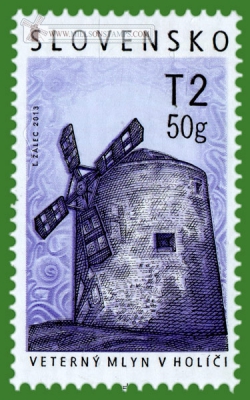-
Technical Monuments: Windmill in Holic
Slovakia 2013.04.26
In issue: Stamp(s): 1
Printing: Rotary recess printing combined with recess printing
Issued in: sheets of 50 (10*5) stamps
-
Perforation type: 11x11 ½
Subject:
Face value of the stamp, type T2 50g, suitable for correspondence up to 50 grams. On the day of the sale - 45 cents.
Windmill in Holic*
Additional:
*Holíč (until 1946 "Holič", German: Weißkirchen (an der March)/Holitsch, Hungarian: Holics) is a town in western Slovakia.
Since time immemorial humans lived in harmony with nature, which provided them with their livelihood, including cereals. They learnt how to use natural forces of water and wind to process them. Wind energy in the Slovak territory was used in its flatter areas that, moreover, were not inundated enough, such as Záhorie and the Eastern Slovak lowlands. There were more than 5 thousand mills using water energy in the 19th century in Slovakia and more than 20 windmills. One of such mills preserved until today is a Dutch-type windmill in Holíč. It is located in the south-eastern part of the city, on the forest’s edge above the Theresian granary. The mill was built in the 1880s and was in use until 1926. The builder of the mill's technology was a joinery master František Sláma from Jevíčko.
The stone cylindrical construction, tapering slightly upwards, originally had a revolving cap, so typical for Dutch-type windmills. The mill’s main stock with sail – the propeller protruded from it. The rotation of the cap together with the sail in the wind’s direction enabled the higher performance of the mill. Rotation was partly automatic, but with greater changes of wind direction and speed, the cap had to be directed with a lever (wound rope or chain) on the pinion’s axle and had to be locked. Wind energy was transmitted by oaken cog gear, consisting of segments in three layers, to a small driven wheel – pinion, multiplying revolutions necessary for the grinding of flour. The horizontal axle’s revolutions were transmitted to the vertical axle, powering the grinding stones. The mill’s technological equipment consisted of a stone structure, i.e. upper rotating stone (runner stone) and lower still stone (bedstone) with a hole for feeding the grit to bags. The flour was separated from the bran in it by horizontal vibration movement derived from a “hasačert” sieve.
The Holíč mill was continuously deteriorating after its decommissioning, until the local hunting association assumed care of it. The revolving cap was replaced by a metal roof, a stylized sail is sunk into building’s external masonry, this it is not able to turn in the wind’s direction.
__________
This information has been taken from Wikipedia and official web page of Slovak Post.
__________
Please, also look at FDC, blackprint and FDS for this issue
Topics: Windmills


